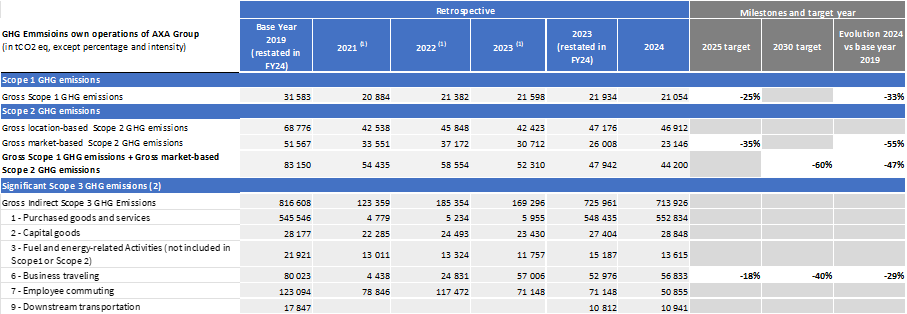
Sustainability
Environmental footprint management
Learn how AXA actively works to reduce its environmental footprint related to its own operations through dedicated management and concrete actions.
AXA, as a responsible company, is committed to addressing climate change through its own operations. Since 2012, an environmental management system has been in place, which includes an annual reporting of Group CO2 emissions from energy consumption, car fleet and business travel. Additionally, water consumption, paper consumption, waste production and recycling are also monitored.
AXA’s environmental footprint is published in AXA’s Universal Registration Document (URD) under Chapter 4: Sustainability.
AXA’s own operations decarbonization ambition
As part of its AXA for Progress Index 2024-2026 AXA Group has set for its own operations as a company the target to contribute to Net-Zero by 2030, i.e. reducing by 50% its GHG emissions related to energy Scopes 1 and 2, car fleet and business travel compared to 2019, while financing carbon credits corresponding to the amount of the residual emissions*.
2019 has been chosen as a baseline year for this target in order to remove the COVID‑19 effect and to ensure a consistent geographic scope following the integration of AXA XL. This target is science‑based and set in accordance with SBTi guidelines** to be compatible with the 1.5°C pathway on Scope 1 and Scope 2, and with a well‑below 2°C pathway on Scope 3.6-Business travel.
The 50% target is distributed as follows:
- By the end of 2030, AXA aims to reduce its Scopes 1 and 2 GHG emissions (energy and car fleet) by 60% compared to 2019.
- By the end of 2030, AXA aims to reduce its Scope 3.6 GHG emissions (business travel) by 40% compared to 2019.
Several measures have been implemented to reach these targets:
To reduce energy Scopes 1 and 2 emissions, AXA aims to source 100% renewable electricity for its operations by end of 2025. In alignment with this objective, AXA has signed a Europe-wide Virtual Power Purchase Agreement (VPPA) in 2023 which is expected to cover electricity needs for all the company’s buildings and data centers in Europe from 2025 and onward, while also supplying renewable energy to the grid. Furthermore, AXA is enhancing energy efficiency in its owned buildings and transitioning to more energy-efficient facilities for sites it does not own.
To reduce car fleet emissions, AXA's Procurement team has led a Europe-wide Request for Proposals (RFP) for car fleets, considering European CO₂ regulations and ecological penalties. Sustainability was a key factor in selecting suppliers, with vehicle GHG emissions and manufacturing countries influencing recommendations to align with AXA's decarbonization goals.
To meet its decarbonization target for business travel, AXA revised its travel framework in 2024. This framework establishes guidelines for all AXA entities, allowing for stricter local policies while maintaining the group established standards. Measures include opting for trains instead of flights for trips under three hours, using public transport over taxis (except in high-risk areas), choosing hybrid or electric taxis over conventional ones, and prioritizing the rental of vehicles with low emissions.
Between 2019 and 2024 AXA’s own operations GHG emissions decreased by 38% (related to energy consumption, car fleet and business travel).

Important: AXA has applied the ESRS for the first time in 2024 and has restated accordingly Baseline 2019 and comparative period 2023.
- 2021 and 2022 data are taken from prior published annual reports.
- Excluding Investments (Scope 3.15).
- For the years 2024, 2023, and the baseline year 2019, additional categories of indirect greenhouse gas (GHG) emissions have been included. These encompass emissions from the procurement of goods and services beyond IT equipment and services (Scope 3.1) and distribution emissions linked to the energy consumption of AXA's agencies (Scope 3.9).
AXA is also implementing measures to decarbonize its Scopes 3.1, 3.2 and 3.3 emissions:
In 2020, AXA Group launched the Digital Sustainability
program, aimed at measuring the carbon footprint of AXA’s digital activities. This program covers emissions from data centers, workplace equipment, and digital service purchases, including cloud computing and network services from key providers. It considers the impact of hardware production and the energy consumption during use. Through this initiative, AXA seeks to identify effective strategies to reduce the environmental impact of its digital activities and enhance its emissions’ management practices.
Additionally, AXA has initiated an internal program for supply chain decarbonization to reduce the emissions associated with the procurement of goods and services. This program specifically focuses on the General Expenses (GenEx
) and IT supply chain, excluding Insurance Procurement (Scope 3.1). With this initiative, AXA has set a target of achieving 66% of General Expenses ('GenEx') and IT suppliers (in spend) having committed to a credible Climate Transition Plan by 2030.
Contributing to net zero
Along with its commitment to reducing the carbon footprint of its own operations, AXA has been financing carbon credits corresponding to the amount of its residual emissions since 2020. AXA's selection process is based on specific criteria, such as: (i) projects must have a significant positive environmental impact; (ii) they must be located in countries where AXA operates; and (iii) they must meet high quality standards through certification (including Gold Standard for the Global Goals, Verified Carbon Standard - Verra, Climate Action Reserve Standard, ISO 14064‑2 standard and CERCARBONO Certified Carbon Standard).
For 2024, the GHG emissions considered were aligned with the scope covered by the 2025 targets***. As a result, AXA has financed the equivalent of 154,46 tCO2 eq carbon credits generated by the following projects:
- Agroforestry Punjab: This project, situated in India, promotes sustainable agroforestry practices to meet this increasing demand for timber and tree‑based products. It aims to provide these materials while conserving and rehabilitating entire ecosystems. Over the course of the 40‑year initiative, the objective is to capture over 1.8 million tons of CO2 eq; (Verified Carbon Standard - Verra).
- Biogas Development Sichuan: This project, located in China, helps avoid carbon emissions and aims at supporting low‑income rural Households in Sichuan with advanced biogas digesters and smoke‑free biogas cookstoves. After switching to biogas, each participating smallholder farmer family saves about 2 tCO2 eq of methane and carbon dioxide emissions every year. This project substantially affects nearly 400,000 rural Households and avoids approximately 800,000 tCO2 eq per year. (Gold Standard for the Global Goals).
- Blue Carbon Tortuga Beach: The Blue Carbon Tortuga Beach project is located in the state of Campeche, Mexico. The project protects and conserves around 995 hectares of mangrove. By selling carbon credits, the project aims to conserve and restore the mangrove forest through activities including reforestation, protection and surveillance against illegal logging, forest sanitation, pest control, soil conservation and environmental education (Climate Action Reserve).
- Improved Forest Management in Durango: This project, located in Mexico, is a forest carbon capture initiative aiming at mitigating climate change through enhanced forest management practices. Spanning over 8,918 hectares, it involves several key interventions including thinning, selective logging, reforestation and soil and water conservation. These activities are designed to enhance carbon removal while promoting sustainable land use. (Climate Action Reserve Standard).
- REDD+ Colombia: This project is a forest conservation initiative in the Amazon region of Colombia, aimed at protecting 130,777 hectares from the threat of unplanned deforestation. It protects around 60,000 hectares of threatened forest in the Mesoamerican Biological Corridor. The project has avoided 5.3 million tCO2 eq. (CERCARBONO Certified Carbon Standard).
- Restoring the Mayan Jungle of Calakmul in Conhu’as: This project, located in Mexico, focuses on the restoration and protection of 47,400 hectares of tropical forest in a rural community. It seeks to conserve local biodiversity and strengthen resilience to climate change and natural disturbances while also addressing fires and illegal logging. (Climate Action Reserve).
- San José del Rincón: This project, located in the Monarch Butterfly Biosphere Reserve in the State of Mexico, aims at improving forest management and promoting reforestation, restoration of degraded areas, fire protection as well as project monitoring. Through improved forest management, reforestation, protection and conservation of 4,839 hectares of forest, this project helps capture approximately 24,101 tCO2 eq per year (Climate Action Reserve standard).
- Soil Capital Climate Change Mitigation Project for Arable Farming in France, Belgium and in the UK: This project, which both generates removal (around 80%) and avoidanc (around 20%) carbon credits, aims at accompanying farmers in the transition of 1 million hectares to more profitable and regenerative agriculture by 2025. Each year, approximately 150, 000 tCO2 eq are estimated to be captured/avoided. (ISO 14064‑2 standard).
- Solar Power Project Ouarzazate: This project, situated 200km southeast of Marrakesh, is part of the world's largest concentrated solar power project. It is expected to feed an annual average of 698 MWh of clean electricity to the Moroccan power grid, thereby improving national energy supply. With the provision of clean energy, the project reduces the amount of power that would otherwise have been generated by fossil‑fueled plants. It contributes to a reduction of approximately 400,000 tCO2 eq per year. (Verified Carbon Standard - Verra).
The average price of these projects is set at €22 per ton of CO2 across the Group, based on a portfolio of carbon credit projects with unit prices ranging from €7 to €78 per ton of CO2. This range reflects the diversity in project types (removal vs avoidance) and locations.
Financing carbon credits enables AXA to meet the expectations of both internal and external stakeholders. Combined with emissions reduction efforts, this approach helps drive energy efficiency initiatives and promotes change in the management of facilities, car fleet, business travel and IT equipment and services. To achieve these goals, AXA engages not only its employees but also its suppliers in finding less carbon-intensive solutions. Additionally, financing carbon credits helps prepare for potential GHG regulations, tax increases or rising energy prices.
(a) Location-based: This method reflects the average emissions intensity of grids on which energy consumption occurs (using mostly grid‑average emission factor data).
(b) Market-based: This method reflects the emissions from electricity that companies have purposefully chosen and where certification of origin can be used. This method is the one used in the target.
Energy, water and waste consumption
In 2024, AXA's total energy consumption was 210,500 MWh, reflecting a 3% reduction from 2023. This decrease is mainly due to site closures, the rationalization of data center infrastructure, and the transition to cloud computing services. Compared to 2019, this represents a 34% reduction, going beyond the 2025 target, largely due to the adoption of hybrid working arrangements, the Smart Working
initiative, and energy sobriety plans in Europe.
At the same time, non-renewable energy consumption decreased by 60% compared to 2019, significantly exceeding the 2025 target of a 10% reduction.

AXA actively monitors consumption indicators for office, marketing and distribution paper, water, and unsorted waste. The implementation of initiatives such as promoting digital information over paper, detecting water leaks, and encouraging recycling contributed to reaching the targets set for 2025 ahead of schedule, in 2024.
For water consumption, the 10% reduction target was exceeded with a 49% reduction achieved in 2024 compared to 2019. Similarly, the waste reduction target of 10% was surpassed, resulting in a 57% reduction over the same period.